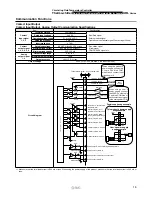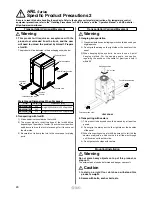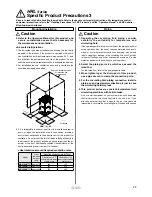
Example 1: When the heat generation amount in the user
’
s equipment is known.
The heat generation amount can be determined based on the power consumption or output
of the heat generating area — i.e. the area requiring cooling — within the user
’
s equipment.
∗
1
Derive the heat generation amount from the power consumption.
Power consumption P: 20 [kW]
Q = P = 20 [kW]
Cooling capacity = Considering a safety factor of 20%, 20 [kW] x 1.2 =
Derive the heat generation amount from the power
supply output.
Power supply output VI: 20 [kVA]
Q = P = V x I x Power factor
In this example, using a power factor of 0.85:
= 20 [kVA] x 0.85 = 17 [kW]
Cooling capacity = Considering a safety factor of 20%,
17 [kW] x 1.2 =
∗
1 The examples above calculate the heat generation amount based on the power consumption.
The actual heat generation amount may differ due to the structure of the user
’
s equipment.
Be sure to check it carefully.
24 [kW]
20.4 [kW]
Required Cooling Capacity Calculation
Example 2: When the heat generation amount in the user
’
s equipment is not known.
Obtain the temperature difference between inlet and outlet by circulating the cir
culating fluid inside the user’
s equipment.
Heat generation amount by user
’
s equipment Q : Unknown [W] ([J/s])
Circulating fluid
: Tap water
∗
1
Circulating fluid mass fl
ow rate qm
: (=
ρ
x qv
÷
60) [kg/s]
Circulating fluid density
ρ
: 1 [kg/L]
Circulating fluid (
v
olume) flo
w rate qv
: 70 [L/min]
Circulating fluid specific heat
C
: 4.186 x 10
3
[J/(kg·K)]
Circulating fluid outlet tempe
rature T
1
: 293 [K] (20 [
°
C])
Circulating fluid retu
rn temperature T
2
: 297 [K] (24 [
°
C])
Circulating fluid tempe
rature difference T
: 4 [K] (= T
2 –
T
1
)
Conversion factor: minutes to seconds (SI units) : 60 [s/min]
∗
1 Refer to page 21 for the typical physical property value of tap w
ater or other circulating fluid
s.
Q = qm
x C x (T
2
– T
1
)
= =
= 19535 [J/s]
≈
19535 [W] = 19.5 [kW]
Cooling capacity = Considering a safety factor of 20%,
19.5 [kW] x 1.2 =
ρ
x qv x C x T
60
1 x 70 x 4.186 x 10
3
x 4.0
60
23.4 [kW]
Derive the heat generation amount from the output.
Output (shaft power, etc.) W: 13 [kW]
Q = P =
In this example
, using an efficiency of 0.7:
= = 18.6 [kW]
Cooling capacity = Considering a safety factor of 20%,
18.6 [kW] x 1.2 =
W
Efficien
cy
13
0.7
22.3 [kW]
Example of conventional units (Reference)
Heat generation amount by user
’
s equipment Q : Unknown [cal/h]
→
[W]
Circulating fluid
: Tap water
∗
1
Circulating fluid
w
eight fl
ow rate qm : (=
ρ
x qv x 60) [kgf/h]
Circulating fluid
weight volume ratio : 1 [kgf/L]
Circulating fluid (
v
olume) fl
ow rate qv
: 70 [L/min]
Circulating fluid specific heat
C
: 1.0 x 10
3
[cal/(kgf·
°
C)]
Circulating fluid outlet tempe
rature T
1
: 20 [
°
C]
Circulating fluid retu
rn temperature T
2
: 24 [
°
C]
Circulating fluid tempe
rature difference T : 4 [
°
C] (= T
2
– T
1
)
Conversion factor: hours to minutes : 60 [min/h]
Conversion factor: kcal/h to kW
: 860 [(cal/h)/W]
Q =
=
=
=
≈
19534 [W] = 19.5 [kW]
Cooling capacity = Considering a safety factor of 20%,
19.5 [kW] x 1.2 =
q
m
x C x (T
2
– T
1
)
860
x q
v
x 60 x C x T
860
1 x 70 x 60 x 1.0 x 10
3
x 4.0
860
16800000 [cal/h]
860
23.4 [kW]
HRL300-A
Calculate based on the laser output.
Laser output power 6 [kW], conver
sion efficien
cy 30%
The oscillator
’
s power consumption is,
6 [kW] ÷ 0.3 = 20 [kW]
The cooling capacity required for the oscillator is,
20 [kW] − 6 [kW]
= 14 [kW]
Considering a safety factor of 20%,
14 [kW] x 1.2 = 16.8 [kW]
HRL
Series
Cooling Capacity Calculation
Q: Heat generation
amount
User’s
equipment
I: Current
Power consumption
V: Power supply
voltage
P
Thermo-chiller
User
’
s
equipment
T
1
: Outlet
temperature
T
2
: Return
temperature qv: Circulating
fluid flow
rate
Δ
T = T
2
– T
1
Q: Heat generation amount
20








































